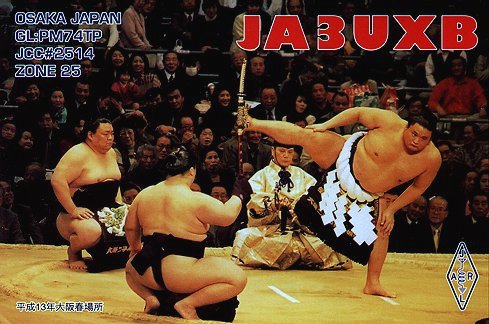 |
| (via QSL.net) |
Then too, some stations have at times issued QSL cards that are very different in style and in appearance. In our program today, we take a look at some quite different and unusual QSL cards.
Back in the early 1970s, BR Bayerische Rundfunk in Germany issued a QSL card that had a rotatable dial attached to the front face. At the time, Bayerische Rundfunk operated a 10 kW shortwave transmitter at Ismaning near to Munich on the 49 m band channel 6085 kHz.
The rotatable disc on this BR QSL card is a thin plastic circular sheet affixed to the card with a thin metal hollow rivet. Upon the clear plastic dial is imprinted a row of 16 curved lines in blue ink. Underneath upon the card a similar pattern of 16 curved rows is imprinted in black ink. As the dial is rotated, varying patterns of interwoven black and blue curved lines are shown.
The 1971 QSL card, dated for reception on April 17, was received by an international radio monitor living in Lahore, Pakistan. The text upon this card is printed in dual languages, German and English.
Back around the same era, the Broadcasting Corporation of Taiwan issued a QSL card that showed four local scenes in color on the picture side. The shape of the card could be described as crenellated, or maybe you could say that there are flanges on each side that look as though they could be folded.
Some international radio monitors have suggested that the card could be folded to look like a small table, and others have suggested that if you take five of these cards, they can be folded and stuck together in the shape of a closed box. The text side of the card is printed entirely in Chinese, and perhaps if this could be translated, maybe the purpose of the card is explained.
This unusual QSL card verifies the reception of their shortwave transmission on 11745 kHz on October 10, 1970. An unusual QSL card prepared for use by amateur station KB9YOZ in Chicago in the United States presents a very large UPC symbol on the picture side of the card. It would be presumed that the bar code symbol on this QSL card would yield a printout of the actual callsign KB9YOZ.
The UPC or Universal Product Code is a bar code symbol that is printed on the side of food packets which are scanned at the checkout in large food shops. This product symbol was invented in the United States, and the very first item that was ever scanned anywhere was a 10-pack of Wrigley’s Juicy Fruit chewing gum at a Marsh Store in Troy Ohio at 8:01 am on June 26, 1974. This food item was worth 67 cents, and it is now on display at the Smithsonian National Museum in Washington DC. The UPC bar code QSL card verified an amateur QSO with VP2MHX in Montserrat in the Caribbean on July 25, 2003.
A QSL card from NHK in Tokyo Japan in 1974 shows an artistic representation in color of a Sumo Wrestler in nine parts. It is suggested that the nine parts shown on the card can be carefully cut out and strung together with thin string to form a dangling picture of the Sumo wrestler.
It is known that some international radio monitors have actually cut up their QSL card and they have hung it dangling fashion in their radio room. However, it is most probable that usually the card is kept in its uncut form in the listener’s QSL collection. Another similar QSL card from NHK Tokyo shows a Samarai Warrior in the same cut out style.
Our copy of this unusual Sumo Wrestler QSL card is dated for reception on July 9 (1974), on 15410 kHz.
(AWR Wavescan/NWS 415)